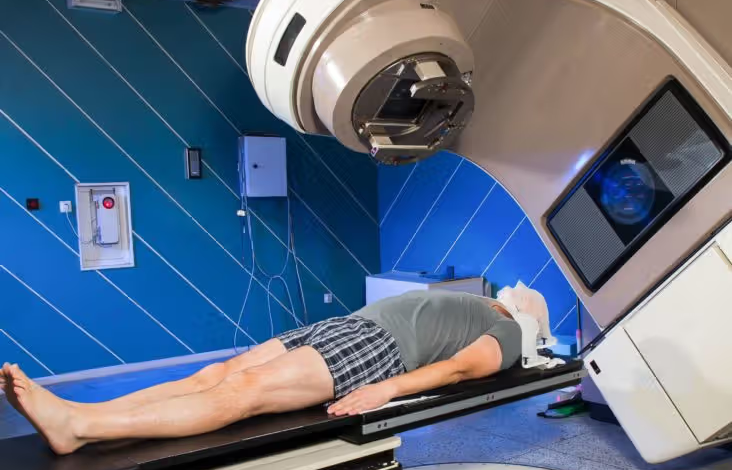How Teletherapy Radiation Targets Cancer Effectively

Cancer is one of the leading health challenges globally. It challenges the patient on both physical and emotional fronts. However, advancements in treatment methods have provided patients with effective options for managing the disease. Among these, teletherapy radiation has emerged as a prominent technique for its ability to target cancer cells while precisely minimising damage to healthy tissues. This non-invasive treatment is widely recognised for improving patient outcomes and quality of life, making it an integral part of cancer care today.
What is Teletherapy Radiation?
Teletherapy radiation, also known as external beam radiation therapy, is a form of cancer treatment where high-energy beams are delivered from a machine outside the patient’s body. The aim is to target and destroy cancer cells while sparing the surrounding healthy tissues as much as possible.
Unlike systemic treatments like chemotherapy, which affect the entire body, teletherapy radiation focuses solely on the tumour. This precision is achieved through advanced imaging techniques, ensuring that the treatment is tailored to the size, shape, and location of the tumour.
The treatment process typically involves a machine called a linear accelerator. Patients lie on a specialised table while the machine directs radiation beams at the affected area. Each session is painless and lasts only a few minutes, allowing patients to continue with their daily lives with minimal disruption.
How Teletherapy Radiation Works
The process begins with a thorough consultation with a radiation oncologist, who evaluates the patient’s medical history and performs imaging tests such as CT or MRI scans. These scans provide detailed information about the tumour’s location, size, and proximity to vital organs.
Using this data, the oncologist develops a personalised treatment plan, specifying the radiation dosage and the number of sessions required. During each session, the patient is positioned carefully on the treatment table to ensure the radiation beams are directed accurately at the tumour.
This targeted approach not only maximises the destruction of cancer cells but also protects healthy tissues from unnecessary exposure. Over multiple sessions, teletherapy radiation effectively reduces the tumour size and minimises the risk of recurrence.
Benefits of Teletherapy Radiation
Teletherapy radiation offers several advantages that make it a preferred option for many cancer patients:
- Non-Invasive Treatment
Unlike surgical procedures, teletherapy radiation does not involve any incisions or physical removal of tissue. This makes it a less traumatic experience for patients, with no risk of post-surgical infections. - Targeted Precision
Advanced imaging technologies enable precise targeting of the tumour. This reduces damage to healthy tissues and minimises side effects, ensuring a safer treatment process. - Minimal Side Effects
While some side effects, such as fatigue or mild skin irritation, may occur, they are generally less severe than those associated with chemotherapy or surgery. - Short Recovery Times
Patients undergoing teletherapy radiation often experience shorter recovery periods compared to those who undergo invasive treatments. Many patients can return to their daily routines shortly after treatment. - Effective Across Various Cancer Types
Teletherapy radiation is suitable for a wide range of cancers, including breast, prostate, brain, and head and neck cancers. Its versatility makes it an essential component of many treatment plans.
Who Can Benefit from Teletherapy Radiation?
Teletherapy radiation is recommended for diverse patients, depending on their medical condition and treatment goals. Key groups who can benefit from this approach include:
- Post-Surgery Patients: It is often used after surgeries like a lumpectomy to eliminate any remaining cancer cells and reduce the risk of recurrence.
- Primary Treatment Candidates: For patients with inoperable tumours or those who cannot undergo surgery due to health conditions, teletherapy radiation serves as a reliable alternative.
- Palliative Care Patients: It effectively relieves pain and other symptoms in advanced stages of cancer, improving the patient’s quality of life.
- Special Populations: Elderly or paediatric patients who may not tolerate invasive treatments frequently benefit from this non-invasive option.
Preparing for Teletherapy Radiation
Preparation plays a crucial role in ensuring the success of teletherapy radiation. Patients should follow these steps to optimise their treatment experience:
- Pre-Treatment Evaluation
Imaging tests such as CT scans or MRIs are conducted to map the tumour and develop an accurate treatment plan. - Lifestyle Adjustments
Patients may be advised to avoid applying creams or lotions to the treatment area before sessions. Maintaining a balanced diet and staying hydrated can also help manage potential side effects. - Building a Support System
Emotional support from family, friends, or support groups can provide encouragement and help patients cope with treatment challenges. - Adhering to Medical Advice
Strict adherence to the treatment schedule and the oncologist’s recommendations is essential for achieving the best results.
Advancements in Teletherapy Radiation
Over the years, teletherapy radiation has seen remarkable advancements that have enhanced its effectiveness. Techniques like Intensity-Modulated Radiotherapy (IMRT) and Image-Guided Radiotherapy (IGRT) allow for precise radiation delivery, ensuring that the beams conform closely to the tumour’s shape. These innovations minimise radiation exposure to surrounding healthy tissues, reducing side effects and improving patient outcomes.
Additionally, imaging and treatment planning developments enable personalised care, making teletherapy radiation a more patient-friendly option.
Considerations During Treatment
While teletherapy radiation is generally well-tolerated, patients should remain aware of potential side effects and discuss them with their medical team. Common side effects include fatigue and mild skin changes, typically resolved after treatment.
Patients should also regularly communicate with their oncologist to monitor progress and promptly address concerns. This collaborative approach ensures a smoother treatment journey and better outcomes.
Conclusion
Teletherapy radiation has revolutionised cancer care by offering a precise, non-invasive, and effective treatment option. Its ability to target tumours directly while minimising harm to healthy tissues makes it an invaluable tool for improving patient outcomes.
Patients considering teletherapy radiation are encouraged to consult with their oncologist to understand how this treatment can be integrated into their care plan. With advancements in technology and personalised treatment approaches, teletherapy radiation continues to bring hope to individuals battling cancer.



